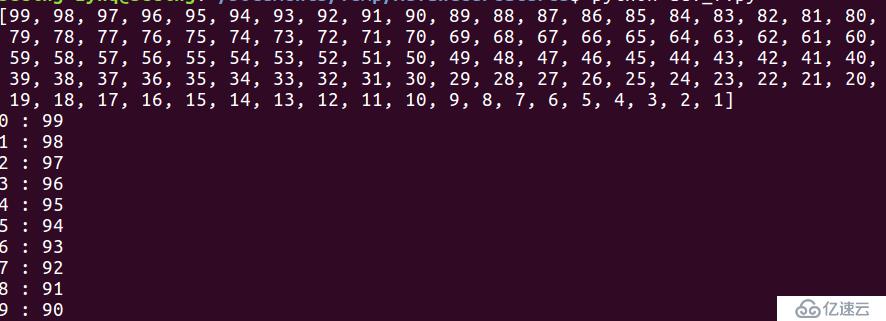您好,登錄后才能下訂單哦!
您好,登錄后才能下訂單哦!
在python 官網的解釋:
class slice(stop)
class slice(start, stop[, step])
Return a slice object representing the set of indices specified by range(start, stop, step). The start and step arguments default to None. Slice objects have read-only data attributes start, stop and step which merely return the argument values (or their default). They have no other explicit functionality; however they are used by Numerical Python and other third party extensions. Slice objects are also generated when extended indexing syntax is used. For example: a[start:stop:step] or a[start:stop, i]. See itertools.islice() for an alternate version that returns an iterator.
一、普通指定范圍方法
#將數字填入L
L = []; #list
n = 1;
while n <= 99:
L.insert(0, n);
n = n + 1;
print L;
#take n in head
n = 10
for i in range(n):
print i, ":", L[i];

二、slice方式
L = []; #list
n = 1;
while n <= 99:
L.insert(0, n);
n = n + 1;
#slice
##follow way:
print "L[0:10]:", L[0:10]; #從第0位開始,第10位結束
print "L[:10]:", L[:10]; # = L[0:10]
print "L[::2]:", L[::2]; # = L[0:100:2] 逢2出1
print "L[-2:]", L[-2:]; # 從左往右,倒數第二位開始
print "L[-2:-1]", L[-2:-1]; # 從左往右,倒數第二位開始 ,倒數第一位結束
print "L[:-90]:", L[:-90];
 print '';
print '';
string = 'abcdef'
print 'string:%s'%string;
print 'string[:3]:', string[:3];
print 'string[::2]:', string[::2];

可見,slice 比 循環還要簡潔。
免責聲明:本站發布的內容(圖片、視頻和文字)以原創、轉載和分享為主,文章觀點不代表本網站立場,如果涉及侵權請聯系站長郵箱:is@yisu.com進行舉報,并提供相關證據,一經查實,將立刻刪除涉嫌侵權內容。